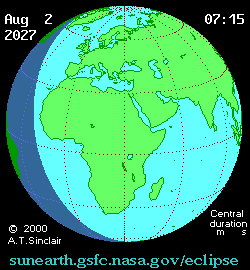“Between Light and Shadow” – The solar eclipse in August 2027 and its echo in ancient Egypt
- mai haikal

- Aug 13
- 3 min read

On August 2, 2027, the skies over Egypt will indeed darken. A total solar eclipse will pass like a dark veil over North Africa, the Middle East, and the Indian Ocean. Over Luxor, the sun will disappear for 6 minutes and 23 seconds—a unique cosmic spectacle, observable for so long and so clearly. But for me, this event is more than an astronomical spectacle—it is a return. A memory. A ritual.
Remembering 2006 – when the sun disappeared and everything became quiet
I was there. In March 2006, when the sun darkened over Sallum in Egypt. I remember not only the light that disappeared—but the silence that spread. The goosebumps as the corona hovered like a silver wreath across the sky. The feeling that the world paused for a moment.
It was as if time itself was listening.
I stood barefoot on the sandy ground, holding a piece of bread in my hand—round and warm like the sun itself. And when the shadow came, I broke it in half. Not out of hunger, but out of reverence. A silent ritual, born of the moment.

Where the sun is silent – affected areas and the length of the darkness
The total phase of the solar eclipse can be admired in these countries – and with impressive time spans:
country | Location | Duration of totality |
🇲🇦 Morocco | Tangier | 4 min 51 sec |
🇪🇸 Spain | Tarifa | 4 min 39 sec |
🇩🇿 Algeria | Oran | 5 min 08 sec |
🇹🇳 Tunisia | Sfax | 5 min 40 sec |
🇱🇾 Libya | Benghazi | 6 min 09 sec |
🇪🇬 Egypt | Luxor (Karnak) | 6 min 21 sec |
🇸🇦 Saudi Arabia | Jeddah | 5 min 56 sec |
🇾🇪 Yemen | Sanaa | 2 min 12 sec |
🇸🇴 Somalia | – | up to 5 minutes |

The darkness spreads across the Atlantic, touching Gibraltar and extending across North Africa to Yemen. It reaches its peak in Egypt—over the ancient temples of Karnak and Luxor, of all places.
A cosmic ritual over the land of the sun
What we celebrate today as an astronomical event with precise calculations and protective goggles was a moment of terror in ancient Egypt—and full of deep symbolism. The solar eclipse was viewed as an ominous omen; it was a sign that the divine order was disrupted. The Egyptians referred to it with the expression "The sky swallows the sun's disk" in hieroglyphs: ˁm-t3-pt-p3-Jtn – Am-ta-pet-pa-Aton.

Darkness was associated with the chaos god Apep , who attempted to devour the sun. At these moments, priests and people came together to protest loudly, drumming, and shouting—a ritual act to save the sun and restore order.
“When the sun is silent, remembering begins.”
The 2027 solar eclipse is not just an astronomical highlight—it's an invitation to pause. It's a reminder that even light occasionally pauses. That darkness can be not only a threat, but also a transition. And that our ancestors, in these moments, observed not only the sky, but also themselves. It might be the right time not only to record this event, but to celebrate it—with a modern ritual that unites science and myth. A song, a loaf of bread, a shared pause, a fragrance. A symbol of honoring the sun and preserving the light within us.
My suggestion for a solar eclipse ritual:
• Location: A quiet place – temple, desert, rooftop terrace
• Time: Shortly before the beginning of totality
Elements:
• A round flatbread – symbol of the sun disk
• A bowl of water – mirror for the returning light
• Scent of myrrh or frankincense – connection to ancient temple rituals
Gesture:
• The bread is broken and a piece is eaten in silence.
• The hands touch the water as soon as the light returns.
• Words: “May the light remain in us, even when the sky is silent.”

Sources and inspiration



Comments